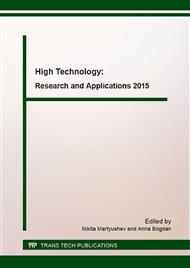[1]
L. Huo, X. -H. Cheng, T. Yang, Aerothermoelastic response analysis for C/SiC panel of ceramic matrix composite shingle thermal protection system, Advances in Space Research, 55 (2015) 2352-2371.
DOI: 10.1016/j.asr.2015.02.008
Google Scholar
[2]
B. Zou, Yu Hui, W. Huang, S. Zhao, X. Chen, J. Xu, Sh. Tao, Y. Wang, X. Cai, X. Cao, Oxidation protection of carbon/carbon composites with a plasma-sprayed ZrB2–SiC–Si/Yb2SiO5/LaMgAl11O19 coating during thermal cycling, Journal of the European Ceramic Society, 35 (2015).
DOI: 10.1016/j.jeurceramsoc.2015.01.015
Google Scholar
[3]
J. Musil , V. Šatava, P. Zeman, R. Čerstvý, Protective Zr-containing SiO2 coatings resistant to thermal cycling in air up to 1400 °C , Surface & Coatings Technology 203 (2009) 1502–1507.
DOI: 10.1016/j.surfcoat.2008.11.026
Google Scholar
[4]
X. Yao, H. Li, Y. Zhang, H. Wu, X. Qiang, A SiC–Si–ZrB2 multiphase oxidation protective ceramic coating for SiC-coated carbon/carbon composites, Ceramics International 38 (2012) 2095–2100.
DOI: 10.1016/j.ceramint.2011.10.047
Google Scholar
[5]
Y.V. Polezhaev, G.A. Frolov, Heat Destruction of Materials. Akademperiodika, Kiev, (2006).
Google Scholar
[6]
T.W. Tong, C.L. Tien. Radiative heat transfer in fibrous insulations-Part I: analytical study. J. Heat Transfer, 105(1983) 70–75.
DOI: 10.1115/1.3245561
Google Scholar
[7]
H. -P. Tan, J. -F. Luo, X. -L. Xia, Q. -Zh. Yu, Transient coupled heat transfer in multilayer composite with one specular boundary coated, Int. J. of Heat and Mass Transfer 46(2003) 731–747.
DOI: 10.1016/s0017-9310(02)00322-8
Google Scholar
[8]
L. Desgrosseilliers, D. Groulx, M. A. White, Heat conduction in laminate multilayer bodies with applied finite heat source, Int. J. of Thermal Sciences 72 (2013) 47–59.
DOI: 10.1016/j.ijthermalsci.2013.05.001
Google Scholar
[9]
R.P. Niu, G.R. Liu , M. Li Inverse analysis of heat transfer across a multilayer composite wall with Cauchy boundary conditions, Int. J. of Heat and Mass Transfer 79 (2014) 727–735.
DOI: 10.1016/j.ijheatmasstransfer.2014.08.041
Google Scholar
[10]
H. Can, Z. Yue, Calculation of high-temperature insulation parameters and heat transfer behaviors of multilayer insulation by inverse problems method, Chinese Journal of Aeronautics, 27 (2014) 791–796.
DOI: 10.1016/j.cja.2014.03.007
Google Scholar
[11]
R. A. Rana, R. Li, Thermal protection from a finite period of heat exposure – Heat survival of flight data recorders, Applied Thermal Engineering 75 (2015) 748-755.
DOI: 10.1016/j.applthermaleng.2014.09.077
Google Scholar
[12]
V.M. Polyaev, V.A. Mayorov, L.L. Vasilev, Hydrodynamics and heat transfer in porous element of aircraft, Machine building, Moscow, (1988).
Google Scholar
[13]
A. P Babichev., N. A Babushkina., A. M Bratkovskii, Energatomizdat, Moscow (1991).
Google Scholar


